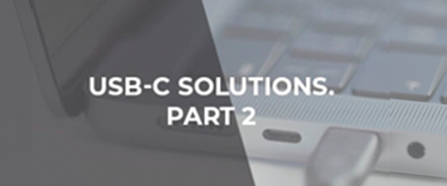Overview of USB-C solutions. Part 2, devices


In the previous part, we discussed the variety of signal transmission lines and installation solutions. Today we will talk about different types of devices equipped with a USB-C port. Some are designed to convert and switch signals, while others perform more utilitarian functions, for example, they can be used as corporate speakerphones, but first things first.
The USB Type-C interface is rightfully considered universal, providing not only connection and charging of peripheral devices, but also high-speed data transfer of various signals, including AV signals in the DP Alt Mode. Kramer VP-424C scaler is equipped with HDMI and USB-C inputs, it allows you to upscale video signals from 640×480/60 to 4K/60 (4:4:4). It supports HDR10, HDCP 2.2, can automatically switch inputs and ensure the constant presence of the sync sign at the output — for example, in case of loss of the input signal.
VP-426C provides similar functionality, but in addition to HDMI and USB-C ports, it also has VGA (for PC) and minijack (stereo audio) inputs. VP-451 has much more features. In addition to upscaling and downscaling of signals, the device provides embedding and de-embedding of analog audio and quite powerful (up to 60 W) charging of smartphones, tablets, Bluetooth speakers and other user devices connected to its USB-C port.
Four devices stand out among Cypress solutions. The CPLUS-31PS switcher supports USB-C, HDMI 2.0, DP 1.4 signals and HDCP 1.x/2.2 providing input and output resolutions up to 4K60 (4:4:4, 8 bit). The CH-1539TXPLPD presentation transmitter and auto switcher handles HDMI, DisplayPort, USB-C, VGA+audio, IR and RS-232 signals, sending them over a HDBaseT twisted-pair cable (CAT5e or higher).
Two remaining devices are multi-format scalers-transmitters. CSC-6030CVE converts HDMI, DP, USB-C, VGA, mic and audio signals and distributes them to parallel HDMI and HDBaseT outputs with PoH support (Power over HDBaseT). CSC-6030HB features 2 RJ45 (female) HDBaseT twisted-pair inputs. Both have a bandwidth of 600 MHz and are designed for high quality sound, as evidenced by a separate output for balanced stereo and a 2×20W/4 Ohm power amplifier.
And of course, various office equipment is also often equipped with the USB-C interface. Take VHD M300 omnidirectional speakerphone with built-in control panel as an example. It supports Bluetooth 5.0, has USB-A and USB-C ports and an AUX output (minijack), thanks to which it can work both in wireless mode and in conjunction with other elements of the audio system installed in a room. It’s a speakerphone that provides full duplex communication, a wireless hands-free system for connecting employees’ mobile phones, and even a portable Bluetooth speaker for listening to music after hours.
- MODULIT SOLUTIONS
- Vilties str. 2, 46326 Kaunas
- Lithuania
- info@modulit.eu